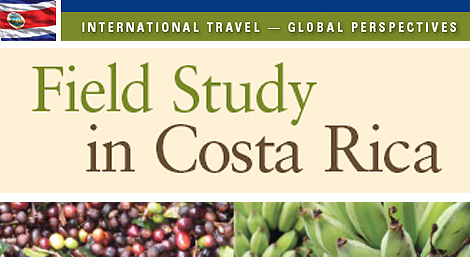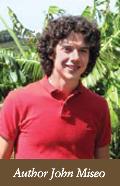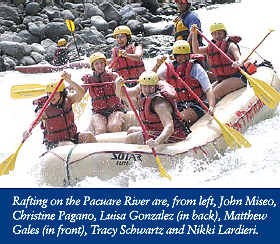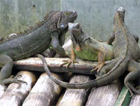

Students traveled to Costa Rica for two weeks during Winter Session to study business, culture and global sustainability. This is the fourth year Daniel and Rosemarie Twomey, professor of management and professor of business law, respectively, have taken students to this small Central-American country. They were also accompanied by Christine Farias, lecturer of economics, who is the faculty adviser to the College at Florham’s Green Club.

Costa Rica offers a unique perspective on global citizenship. In 1948, the country abolished its army, dedicating the funds it saved to the nation’s education system instead. Consequently, the literacy rate is more than 96 percent. Known as a nation of abundant natural beauty, more than a quarter of its land is designated as national parks and nature preserves.
John Miseo, a senior business management major, traveled to Costa Rica because he wanted to better understand how business is conducted internationally. He offers the following account of his first-ever trip to Central America.

lying over Costa Rica, I was struck by the country’s natural beauty as I gazed outside the tiny window at the crisp blue seas and lush forests below. In 1502, Christopher Columbus accidentally stumbled upon this tiny, mountainous country in Central America. Rumors of gold and other precious-metal deposits contributed to the nation’s name, which means “rich coast” in Spanish.
For the first few days of our journey, we stayed in San Jose at INCAE Business School, a graduate-level institution founded with the assistance of Harvard Business School more than 40 years ago. We attended various lectures and discussed how Latin-American countries can compete in today’s global marketplace.
During Spanish Colonial times, Costa Rica was unable to establish profitable trade routes due to its distance from Guatemala City, the region’s premier trading area. Although this allowed the nation to develop freely with little intervention from the crown, it also caused economic failure: Costa Rica was once considered to be the poorest colony in Central America. Currently, the government operates as a democratic republic, with Nobel Peace Prize winner Oscar Arias Sánchez presiding over its seven provinces, and a total population of more than 4 million people.
Sustainable development was a recurring theme throughout the trip, and can be defined as a balanced approach: consumers and businesses need to satisfy today’s needs without compromising the needs of future generations. Considering the widespread concern about climate change in the world today, it is refreshing to know that Costa Rica is a world leader in environmental conservation and sustainability. The locals sum this up with the phrase pura vida, which literally translates into “pure life.” This state of mind embodies a philosophy of strong community and family ties, in addition to a close bond with Mother Nature.
We toured the Doka Estate, a full-scale coffee plantation that implements long-term strategies to conserve soil and is continually working to reduce pesticide use. Despite the fact that the country’s main export is computer chips and less than 10 percent of the total gross domestic product comes from agriculture, it was fascinating to see coffee production from start to finish.

We spent a full day rafting down the Pacuare River, which is located on the country’s Atlantic slope and borders the Cordillera de Talamanca mountain range. Recently, National Geographic proclaimed it “one of the most beautiful rivers in the world.”
Due to the recent explosion of foreign direct investment, the country is unable to meet consumer demand for electricity. As a result, the government has considered building a dam on the Pacuare to generate hydroelectricity. This would destroy ecosystems and kill endangered species living nearby. Countless indigenous villages surrounding the river would be sacrificed, and the tourism industry would be adversely affected.
We debated the pros and cons of the proposed dam throughout the trip and were unable to reach a consensus, but then again, the government has been debating this issue for nearly 20 years.
Next, we took an all-access tour of Bananero S.A., a midlevel banana plantation in Siquirres. It was interesting to see how simple yet time-consuming banana production can be. People employed there are fortunate enough to earn a decent wage and have union representation. The company also tries to minimize pesticide use and has a rigorous recycling program in place.

Later in the week, we traveled to Earth University, an international agricultural school in Guacimo. This institution is working toward becoming “carbon neutral” and generates electricity by fermenting animal manure. The university also grows bananas as organically as possible in Costa Rica’s hot and humid climate and sells them to the Whole Foods Market chain. Nothing is wasted during the production process. Even the discarded banana stalks are used to make paper.
During our last week in Costa Rica, we stayed on the Caribbean coast in Manzanillo. The accommodations were in the middle of a wildlife refuge and can only be described as “jungle houses.” We hiked through the dense rainforest with an experienced guide, who pointed out countless plants that exhibited medicinal qualities, and encountered colorful frogs, poisonous snakes, beautiful birds, lazy sloths and excited monkeys. Later in the week, we went on a dolphin watch and attended a lecture at the Talamanca Dolphin Foundation.
To learn about the economy in a small beach community, students were assigned to interview local business owners. My partner and I interviewed a tour guide and presented our findings to the class and the neighborhood at a local restaurant.

At the Kekoldi Indigenous Reserve, we toured a farm, hiked through the forest and were treated to a traditional chicken lunch, served in a large leaf.
One of my favorite activities of the trip was the service-learning project, which consisted of a beach cleanup and the planting of coconut trees to reduce erosion.
Although the howler monkeys promptly woke me up at 5 a.m. every morning, this trip was a life-changing experience. I have become more aware of my impact on the environment and am working to reduce my footprint. As future business leaders, we need to understand that tiny changes in daily activities can make a huge impact on the world.
Have you had a memorable FDU study-abroad experience? FDU Magazine has created a blog for readers to share their stories. Go to myfdu.net/blog/fdumagazine.
FDU Magazine Home | Table of Contents | FDU Home | MyFDU.net | Blog About It
©Copyright 2008 Fairleigh Dickinson University. All rights reserved.
For a print copy of FDU Magazine, featuring this and other stories, contact Rebecca Maxon, editor,
201-692-7024 or maxon@fdu.edu.